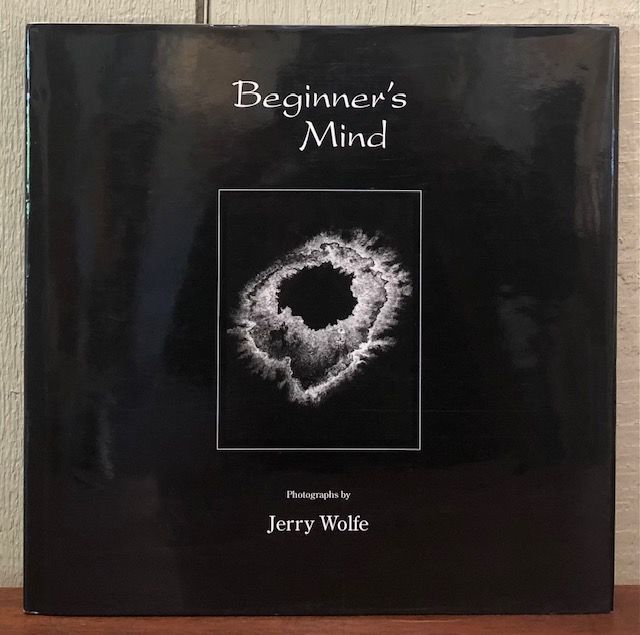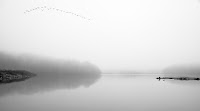 When I was still in my teens, and just starting to learn photography, I recall two pivotal moments after which whatever doubts I may have had at the time about seriously pursuing photography evaporated, never to be heard from again. I described the first moment in an earlier blog entry; it amounts to seeing Minor White's "abstract expressionist"-like "Capitol Reef" print for the first time. I will not repeat what I wrote before, except to emphasize the spiritual awakening that White's image evoked in me. I realized for the first time that photography could be used to express not just the "objective" world - as it appears here and now, on the "outside" - but also an intensely subjective, private world that describes our very soul and its relationship to the corporeal.
When I was still in my teens, and just starting to learn photography, I recall two pivotal moments after which whatever doubts I may have had at the time about seriously pursuing photography evaporated, never to be heard from again. I described the first moment in an earlier blog entry; it amounts to seeing Minor White's "abstract expressionist"-like "Capitol Reef" print for the first time. I will not repeat what I wrote before, except to emphasize the spiritual awakening that White's image evoked in me. I realized for the first time that photography could be used to express not just the "objective" world - as it appears here and now, on the "outside" - but also an intensely subjective, private world that describes our very soul and its relationship to the corporeal.The second moment, which occurred at roughly the same time in my life, took place as I was ponderously reading a rather dry textbook on photography; and is a direct precursor of why I am now so excited (30 years later!) by a magnificent lens filter available from Singh-Ray. Going back to my old self at 17, I remember being curled up in bed one day, while skimming through some pages explaining the basics of exposure. It was all standard material, with equally standard (meaning somewhat "dull") illustrations and photos highlighting the central points of the text. And then I ran across what I, at the time, thought was a stunningly dull photo: an image of an empty highway, taken in broad daylight. No cars, no pedestrians, no birds, nothing but asphalt and concrete. "Wow," I remember thinking, "these guys could use some creativity pills if this is the best they can do to illustrate a text on photography!" But it was a curiously puzzling photo, and strangely mesmerizing in its own way. I couldn't take my eyes off it for some reason. I kept asking myself, "Why aren't there any cars on this long stretch of highway in the middle of the day?" After reading the text more carefully (there was no caption underneath the picture except for the figure number), I had my second epiphanous moment.
 The reason the picture showed nothing but an empty highway was because - during the extremely long exposure (about 1 min!) - nothing was in the frame long enough to register on the film! And how did that happen? Because the author was illustrating an effect of attaching a strong neutral density filter to the lens (in addition to using a very small aperture). A neutral density filter (NDF) reduces the intensity of light (at all wavelengths), thereby increasing the effective exposure time as the amount of reduction increases. NDFs are typically rated by the number of "f-stops"-worth of light reduction they impose.
The reason the picture showed nothing but an empty highway was because - during the extremely long exposure (about 1 min!) - nothing was in the frame long enough to register on the film! And how did that happen? Because the author was illustrating an effect of attaching a strong neutral density filter to the lens (in addition to using a very small aperture). A neutral density filter (NDF) reduces the intensity of light (at all wavelengths), thereby increasing the effective exposure time as the amount of reduction increases. NDFs are typically rated by the number of "f-stops"-worth of light reduction they impose.For example, if a "filterless" exposure at f8 is, say, 1/500 sec, then a "2 f-stop" NDF will increase the exposure to 1/125 sec (at the same aperture); and an "4-stop" NDF will further increase it to 1/30 sec. Of course, one has to be sure that the white balance is preserved (so that there are no extraneous color shifts); which in practice simply means that you'll be investing in more expensive brands. I always carry at least two NDFs in my bag, one 3f-stop and one 6f-stop. The range is important, for it allows me to "experiment" with, say, a "frozen" water stream (using a fast exposure), a stream that is delicately blurred (for exposure times between 1/4 - 1 sec), and cloud-like flow "abstractions" (for t>5 sec).
 However, despite the aesthetic allure of photos taken with my NDFs, I have often felt overly constrained by being able to reduce my exposure only by a fixed amount, as allowed and defined by a given filter's f-stop rating. Until, that is, a few weeks ago when I stumbled upon a remarkable variable neutral density filter - called a vari-ND - by Singh-Ray.
However, despite the aesthetic allure of photos taken with my NDFs, I have often felt overly constrained by being able to reduce my exposure only by a fixed amount, as allowed and defined by a given filter's f-stop rating. Until, that is, a few weeks ago when I stumbled upon a remarkable variable neutral density filter - called a vari-ND - by Singh-Ray.  The vari-ND allows the user to "dial-in" any desired level of light attenuation between two and eight f-stop's worth, simply by rotating a ribbed ring on the filter. Apart from the technical acumen required to make this work, by providing the photographer near instant control over a vast continuous range of effective exposures makes the vari-ND a truly remarkable device.
The vari-ND allows the user to "dial-in" any desired level of light attenuation between two and eight f-stop's worth, simply by rotating a ribbed ring on the filter. Apart from the technical acumen required to make this work, by providing the photographer near instant control over a vast continuous range of effective exposures makes the vari-ND a truly remarkable device. Well, I've had this magic filter - and it is magic! - for a few weeks, and had a chance to experiment "Seeing" with it; some examples of which you see sprinkled throughout this post. It works precisely as advertised, and is a lesson in elegant design and workmanship. There are two sizes - 77mm and 82 mm - which is not a problem for those (like me) with smaller sized lens, since you can always use a step-up ring to match the filter. Indeed, having a smaller lens is actually an advantage, since you reduce the possibility of vignetting at wider-angles.
Well, I've had this magic filter - and it is magic! - for a few weeks, and had a chance to experiment "Seeing" with it; some examples of which you see sprinkled throughout this post. It works precisely as advertised, and is a lesson in elegant design and workmanship. There are two sizes - 77mm and 82 mm - which is not a problem for those (like me) with smaller sized lens, since you can always use a step-up ring to match the filter. Indeed, having a smaller lens is actually an advantage, since you reduce the possibility of vignetting at wider-angles. Objectively speaking, the vari-ND does not provide anything that a photographer cannot achieve in other ways, using other tools. But oh how magnificently effortless vari-ND renders that work! If the possibility of creating lasting works of art depends, in even small measure, on the artist being unburdened from logistical/technical constraints, then - I say - the vari-ND is truly a magic filter! It is brilliant in conception, flawless in design, and produces stunning images.
Objectively speaking, the vari-ND does not provide anything that a photographer cannot achieve in other ways, using other tools. But oh how magnificently effortless vari-ND renders that work! If the possibility of creating lasting works of art depends, in even small measure, on the artist being unburdened from logistical/technical constraints, then - I say - the vari-ND is truly a magic filter! It is brilliant in conception, flawless in design, and produces stunning images.  If you are a seasoned photographer looking to expand your creative possibilities, have just started exploring the dynamics of light and exposure, or have ever wondered what it would be like to control up to 8 f-stops worth of light with a simple twist of a filter, go here, and order one of these magical devices for yourself. You won't regret it!
If you are a seasoned photographer looking to expand your creative possibilities, have just started exploring the dynamics of light and exposure, or have ever wondered what it would be like to control up to 8 f-stops worth of light with a simple twist of a filter, go here, and order one of these magical devices for yourself. You won't regret it!A philosophical postscript: I use the word "magic" in the title and in my reference to the vari-ND for two reasons. The first reason has already been hinted at in the text above, and has to do with how this filter "magically" renders effortless the willful imposition of desired exposure time (on a technical level). The second reason, unarticulated explicitly above, is decidedly philosophical. What this filter does, in effect, is to transform our normal, every-day perception of temporal flow - in which the world appears to move in localized snippets of time that last roughly 1/30 to 1/60sec - to glimpses of a supranormal, otherwordly, realm in which time moves at a slower, sometimes significantly slower, pace. It thereby also transforms us into temporally transcendent beings, that temporarily exist outside of time, and are able to marvel at time's own inner rhythms. Who is to say what is "real", and what is not? Is the "real" stream of water the one my eyes provide a visual imprint of?" Or is it the ethereal cloud of vapor that my "temporally transformed" eye glimpses, however briefly, with the aid of the vari-ND? Both are "real", but neither is definitively so, of course. Moreover, I would argue, it is this simple, but profound, realization that we have momentarily stepped "outside the normal flow of perceived time" - along with the even deeper realization that the clearest view of reality can only take place from some vantage point outside of it, on a meta-level - that points the way toward something approaching a "spiritual" enlightenment. Thus, the second reason I use the word "magic" in describing the vari-ND, is that it "magically" reveals a (normally hidden) spiritual realm.



























